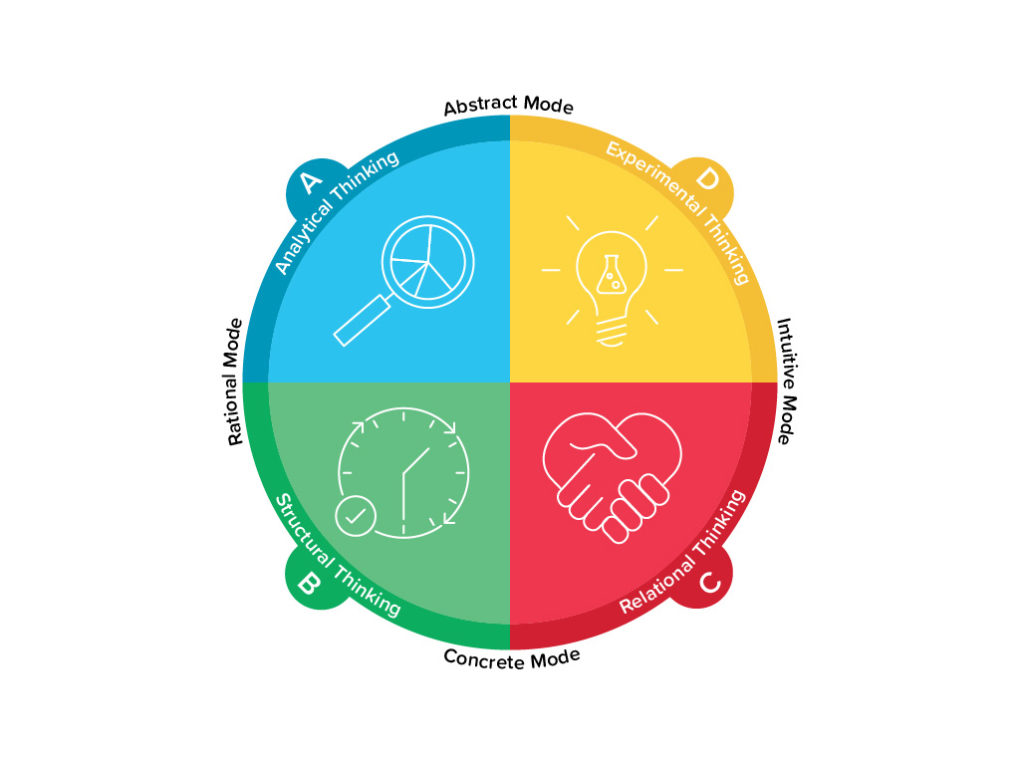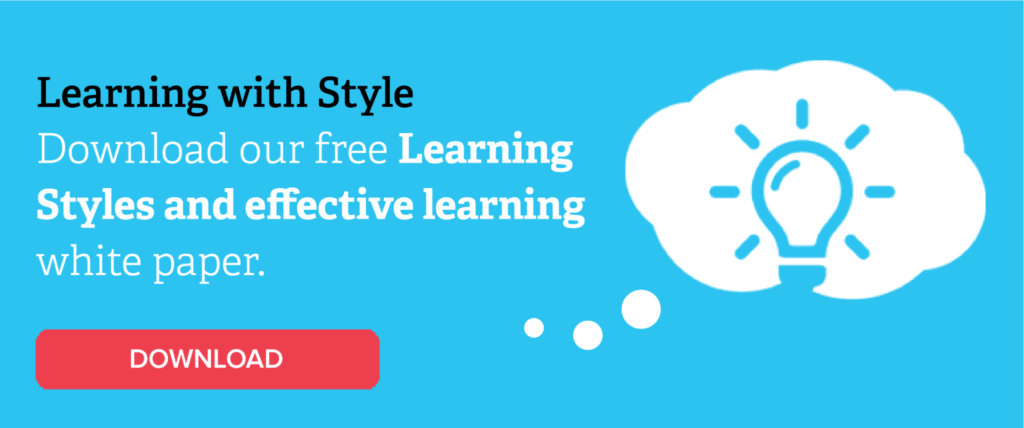This article is adapted from Ned Herrmann’s original paper: Creativity, Learning and the Specialised Brain In the Context of Education for Gifted and Talented Children*
I would like to acquaint you with my specialised language, which is the new language of brain dominance technology. In pursuing the nature of creativity and discovering that its source was the brain, I really came to grips with what I think is a fundamental understanding: If the brain truly is the source of creativity (and it must be), then all human functioning is affected by the way we think.
Defining creativity
People ask, ‘Ned, what is your definition of creativity?’ But I really want to avoid defining it, because for each of us it has a different meaning. The following statement is as close as I would like to come: Among other things, creativity is the ability to challenge assumptions, recognise patterns, see in new ways, make connections, take risks, and seize upon a chance.
Of course, all these aspects of creativity come from the brain. The human brain is something which we as a culture, we as a civilisation, we as a people, we as individuals, have not done our homework on. We don’t teach the brain. We should! Most of us don’t understand it. We need to.
It’s important for us to grasp the overall significance of the brain, because, in point of fact, every emotion, every thought, dream, act, bodily function of our waking and sleeping self is ruled by the brain – a vast network of neural activity. Most of us know more about our phones or our cars than we know about the brain. I’m going to try to deal with that issue in this article.
Introducing Herrmann and Whole Brain® Thinking
The Herrmann Whole Brain® Thinking Model can be thought of as a metaphor of how the human brain works. It is a metaphor which permits us to move beyond the strict physiological location of specialised modes, and deal with the brain system as an abstract concept with, perhaps, more clearly defined boundaries than neurophysiology allows.
This model is made up of four separate quadrants, A, B, C, and D. We have:
- the logical, analytic, quantitative, fact-based A quadrant
- the planned, organised, detailed, sequential B quadrant
- the emotional, interpersonal, feeling-based, and kinesthetic aspects of the C quadrant; and
- the holistic, intuitive, synthesising, and integrating modes of the D quadrant.
The four-colour quadrant graphic and Whole Brain® are registered trademarks of Herrmann Global, LLC. ©2015 Herrmann Global, LLC
The Herrmann Brain Dominance Instrument® (HBDI®) is based on this metaphoric model. In interpreting the resulting data, I emphasise that I do not consider the HBDI® to be a ‘test’. That would imply right or wrong or good or bad. Rather, the instrument is simply a model showing a distribution of mental preferences in the form of a four-quadrant profile.
Learning styles and the Whole Brain® Model
One way of categorising the four dimensions of the model is: A – know it; B – do it; C – sense it; and D – try it. These specialised modes lead immediately to different learning styles.
The A quadrant learns by acquiring and quantifying facts, applying analysis and logic, thinking through, building cases, forming theories. This learning style is in contrast with the B quadrant which learns by organising and structuring concepts, sequencing, evaluating, testing, acquiring skills through practice. This in turn is quite different from the C quadrant which listens and shares, integrates, experiences, moves and feels, harmonises and has emotional involvement. The D quadrant takes initiative, explores different possibilities, relies on intuition, is interested in self – discovery, constructs concepts, and synthesises.
It is essential for us to understand that the concept of thinking preferences deals with personal differences and uniquenesses and not with good or bad, or right or wrong. We all tend to have these preferences and we should think of them more as potential sources of competencies than as problem issues.
Our preferences for one mode or another inevitably lead to preferred thinking styles. For example, the thinking style of the upper left A quadrant is that of analyst, and of the upper right D quadrant, that of synthesist. The lower left B quadrant is conservatist. Finally, the humanistic feelings of the C quadrant represent thinking just as much as the fact-based modes. They are just different approaches.
Finding creativity (even if we’re not ‘creative’)
Creativity is not a privileged domain for the select few but rather a part of life available to all of us. When we assume that a person is not creative, and worse, when we teach a person that he or she is not creative, we stifle an important part of that person’s life. When we assume that a child is not gifted or talented, without first seeking to discover the child’s gifts and talents, we stifle that child’s potential.
Our strongest preferences lead to our greatest competencies and our avoidances lead to our least competencies. In terms of learning strategy, we should affirm or extend our preferences. We should reinforce and develop our secondaries and be stimulated and challenged in our areas of avoidance. I do not feel that we should let students off the hook (or ourselves for that matter) in areas that we have not yet accessed or developed.
Many of us do not even know they exist, and so we need to find ways to stimulate and challenge them. As educators we must understand that as we move individuals into situations out of their area of competence, we should have different expectations of their ability to learn and perform.
Whole Brain® Teaching and Learning
Out of brain dominance concepts developed a model of what I call Whole Brain® teaching and learning. In the A quadrant, we deal with rational, cognitive, and quantitative modes. All are important and are basically fact-based. In the B quadrant are the organised, sequential, procedural aspects of learning which, taken together with A, are the most structured and verbal part of our processing. In the C quadrant are the feeling oriented emotional, expressive, and interpersonal modes which contrast with the controlled A and B. The D quadrant contains the visual, conceptual, simultaneous aspects. C and D taken together are experiential and non-verbal.
These are four very different modes and if we as designers and teachers ignore those differences, the student will simply not understand. The person who is strongly oriented to one particular learning mode will tend to fight and reject or not process effectively the other modes. Again, the world as a whole is a composite whole brain, and so we must now begin to change our assumptions about the learning styles of our students to accommodate those who think in ways different from ourselves and our schools.
Activities in the A quadrant include analysing, objectifying, articulating, and finance training programs. In the B quadrant are planning, organising, administrative, and evaluative activities. C quadrant includes interpersonal, team oriented, and emotive activities. In the D quadrant we conceptualise, strategise, design, and integrate.
In identifying gifted and talented children, I believe that we’ve been over-selective and have used the wrong criteria for that selection. My experience over the past decade of using whole brain teaching and learning methods provides overwhelming evidence that we all have latent creative potential that can be accessed and made visible. ‘Creativity is the breaking down of walls rather than the building of skills,’ realised a young man after attempting a sculpture for the first time. ‘I finally was able to slay the self-created dragon that prevented me from doing what I had wanted to do all of my life.’ We must summon the courage to attack the inflated dragon that blocks our personal creativity.
Facilitating a better learning environment
I firmly believe that composite Whole Brain® learning groups represent the ultimate teaching configuration. I realise this imposes an enormous administrative difficulty on people, to assemble such a rare group, but I attempt to change the organisational culture of the businesses and schools I work with in order to make that possible. I solve that problem by gathering together people who are different and unique. In effect, I create a participant pool of interested learners that as a group represent a composite Whole Brain®. This allows me to pick people in pairs, triads, and communities so that their similarities and differences provide an opportunity for them to learn from each other.
As I summarise the brain and learning, I see these kinds of major issues:
- The brain is specialised.
- The individual brain is unique.
- The brain is situational.
- Learning is mental.
- Each individual has different learning styles.
- Learning designs can accommodate individual differences.
- Delivery of learning can respond to personal uniqueness.
- Unique people can be made an integral part of the learning design.
- Learners can be grouped to make learning more effective.
- Learning through affirmation and discovery can be more effective, more fulfilling, and last longer.
- Learning programs that are based on the specialised brains of the unique participants work to the advantage of everyone, including the teacher or trainer.
IQ tests are not a true measure of intelligence. My personal feeling is that IQ tests are an abomination. They give wrong information – either high or low. It’s wrong because it gives you misleading clues as to what true intelligence is. High IQ scores do not insure success. My experience with business people – with adults with whom I work – shows that there is no strong correlation between IQ and success. As a matter of fact, over specialisation can get in the way. A study by Forbes magazine dealing with the 800 most powerful people in the United States, showed that of the top 100, 22% had no college degree at all, 50% were at the bachelor level, and only 17% were MBAs. Intelligence is more than lots of knowledge. It’s also intuition, insight, and inspiration.
Interested in learning more about Whole Brain® Thinking and how it can help you reach your full potential as an educator? Download our free Learning Styles and effective learning white paper.



